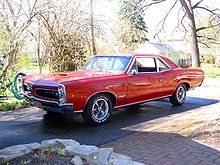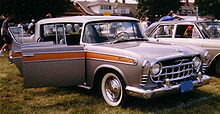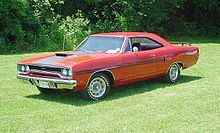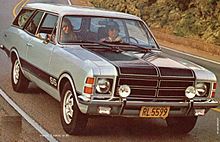- Muscle car
-
Muscle car is a term used to refer to a variety of high performance automobiles.[1] The Merriam-Webster definition is more limiting, "any of a group of American-made 2-door sports coupes with powerful engines designed for high-performance driving."[2] The term generally refers to 2-door rear wheel drive family-style 4+ passenger mid-size cars (and, by some, full-size cars) equipped with large, powerful, V8s, and sold at an affordable price for mainly street use and sometimes both formal and informal drag racing.[3][4][5][6]As such, they are distinct from two-seat sports cars and expensive 2+2 GTs intended for high-speed touring and road racing.
Building on the American phenomenon and developing simultaneously in their own markets, muscle cars also emerged in their own fashions in Australia, South Africa, the UK, and elsewhere.
Contents
Definition
According to the June 1967 issue of Road Test magazine, a "muscle car" is "exactly what the name implies. It is a product of the American car industry adhering to the hot rodder's philosophy of taking a small car and putting a BIG engine in it. The Muscle Car is Charles Atlas kicking sand in the face of the 98 hp (73 kW) weakling."[7] Peter Henshaw, the author of the book Muscle Cars, from which this quote is drawn, further asserts that the muscle car was designed for straight-line speed, and did not have the "sophisticated chassis", "engineering integrity" or "lithe appearance" of European high-performance cars.[7]
However, opinions vary as to whether high-performance full-size cars, compacts, and pony cars qualify as muscle cars.[8]
The following is a list of muscle cars and their manufacturers (along with each make's corresponding pony car, where applicable):
Development
Early muscle
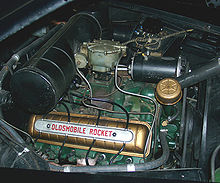 1949 Rocket 88 engine
1949 Rocket 88 engine
 Hudson Hornet: Rocket 88's only competitor
Hudson Hornet: Rocket 88's only competitor
Opinions on the origin of the muscle car vary, but the 1949 Oldsmobile Rocket 88, created in response to public interest in speed and power, is often cited as the first of the breed. It featured an innovative and powerful new engine—America's first high-compression overhead valve V8 in the smaller lighter Oldsmobile 76/Chevy body for 6 cylinder engines(as opposed to bigger Olds 98 luxury body).[9]
Musclecars magazine wrote: "[t]he idea of putting a full-size V8 under the hood of an intermediate body and making it run like Jesse Owens in Berlin belongs to none other than Oldsmobile... [The] all-new ohv V8...Rocket engine quickly found its way into the lighter 76 series body, and in February 1949, the new 88 series was born."[10]
The article continued: "Walt Woron of Motor Trend enjoyed the 'quick-flowing power...that pins you to your seat and keeps you there until you release your foot from the throttle [...] Olds dominated the performance landscape in 1950, including wins in the NASCAR Grand National division, Daytona Speed Weeks, and the 2100-plus-mile Carrera Panamericana. In (Belgium), an 88 won a production car race at Spa-Francorchamps [...] A husky V8 in a cleanly styled, lightweight coupe body, the original musclecar truly was the '49 Olds 88."[10]
Jack Nerad wrote in Driving Today: "the Rocket V-8 set the standard for every American V-8 engine that would follow it for at least three decades [...] With a displacement of 303 cubic inches and topped by a two-barrel carburetor, the first Rocket V-8 churned out 135 hp (101 kW; 137 PS) at 3,600 rpm and 263 pound-feet of torque at a lazy 1800 rpm [and] no mid-range car in the world, save the Hudson Hornet, came close to the Rocket Olds performance potential..."
Nerad added that the Rocket 88 was "the hit of NASCAR’s 1950 season, winning eight of the 10 races. Given its lightning-like success, one could clearly make the case that the Olds 88 with its 135 horsepower (101 kW) V-8 was the first 'musclecar'..."[11]
Steve Dulcich, writing in Popular Hot Rodding, also cites Oldsmobile, concurrently with Cadillac, as having "launched the modern era of the high-performance V-8 with the introduction of the "Rocket 88" overhead-valve V8 in 1949."[12]
Growth of the trend
 1955 Chrysler C-300, "America's most powerful car", had 300 horsepower (220 kW)
1955 Chrysler C-300, "America's most powerful car", had 300 horsepower (220 kW) America's fastest 1957 sedan: Rambler Rebel had lightweight unibody construction and V8 engine
America's fastest 1957 sedan: Rambler Rebel had lightweight unibody construction and V8 engine
Other manufacturers "showcased performance hardware in flashy limited-edition models. Chrysler led the way with its 1955 C-300, an inspired blend of Hemi power and luxury-car trappings that fast became the new star of NASCAR. With 300 horsepower (224 kW), it was rightly advertised as 'America's Most Powerful Car.'"[9] (With a limited option 2 4-barrel carburetors 355 hp engine also available)
Capable of accelerating from 0 to 60 mph (97 km/h) in 9.8 seconds and reaching 130 miles per hour (209 km/h), the 1955 Chrysler 300 is also recognized as one of the best-handling cars of its era.[13] Two years later the Rambler Rebel was the fastest stock American sedan, according to Motor Trend.[14]
The popularity and performance of muscle cars grew in the early 1960s, as Mopar (Dodge, Plymouth, and Chrysler) and Ford battled for supremacy in drag racing. The 1962 Dodge Dart 413 cu in (6.8 L) Max Wedge, for example, could run a 13-second 1/4-mile dragstrip at over 100 miles per hour (161 km/h). By 1964, General Motors' lineup boasted Oldsmobile, Chevrolet, and Pontiac muscle cars, and Buick fielded a muscle car entry a year later. For 1964 and 1965, Ford had its 427 cu in (7.0 L) Thunderbolts, and Mopar unveiled the 426 cu in (7.0 L) Hemi engine. The Pontiac GTO was an option package that included Pontiac's 389 cu in (6.4 L) V8 engine, floor-shifted transmission with Hurst shift linkage, and special trim. In 1966 the GTO became a model in its own right. The project, spearheaded by Pontiac division president John DeLorean, technically violated GM's policy limiting its smaller cars to 330 cu in (5.4 L) displacement, but the new model proved more popular than expected and inspired GM and its competitors to produce numerous imitators. The GTO itself was a response to the Dodge Polara 500 and the Plymouth Sport Fury, which in 1962 had been shrunk to intermediates—at a time when bigger was considered better.
American Motors, though late entering the muscle car market, produced "an impressive array of performance cars in a relatively short time," said Motor Trend. "The first stirrings of AMC performance came in 1965, when the dramatic if ungainly Rambler Marlin fastback was introduced to battle the Ford Mustang and Plymouth Barracuda."[15] Although the Marlin was a flop in terms of sales and initial performance, AMC gained some muscle-car credibility in 1967, when it made both the Marlin and the "more pedestrian" Rebel available with its new 280 hp (209 kW; 284 PS), 343 cu in (5.6 L) "Typhoon" V8. In 1968 the company offered two pony car muscle car contenders: the Javelin and its truncated variant, the AMX.[15]
Although the sales of true muscle cars were relatively modest by total Detroit production standards, they had value in publicity and bragging rights. Competition between manufacturers meant that buyers had the choice of ever-more powerful engines—a horsepower war that peaked in 1970, with some models advertising as much as 450 hp (336 kW; 456 PS).
Turn-key drag racers
Muscle cars attracted young customers (and their parents) into showrooms, and they bought the standard editions of these mid-size cars. To enhance the "halo" effect of these models, the manufacturers modified some of them into turn-key drag racers.
For example, Ford built 200 lightweight Ford Galaxies for drag racing in 1963. All non-essential equipment was omitted. Modifications included fiberglass panels, aluminum bumpers, traction bars, and a competition-specification 427 cu in (7.0 L) engine factory-rated at a conservative 425 hp (317 kW; 431 PS). This full-size car could run the quarter mile in a little over 12 seconds.[16] Also built in 1963 were 5,000 road-legal versions that could be used every day. (Ford claimed 0-60 in less than 6 seconds for the similarly powered 1966 Galaxie 500XL 427.)[7]
Another Ford lightweight was the 1964 Ford Thunderbolt that utilized the mid-size Fairlane body. A stock Thunderbolt could run a quarter-mile (402 m) at a drag strip in 11.76 seconds at 122.7 mph (197.5 km/h),[17] and Gas Ronda dominated the NHRA World Championship with a best time of 11.6 seconds at 124 mph (200 km/h).[7] The Thunderbolt included the 427 engine with special exhausts—though technically legal for street use, the car was too raucous for the public roads—"not suitable", according to a Hot Rod magazine quote, "for driving to and from the strip, let alone on the street in everyday use";[17] also massive traction bars, asymmetrical rear springs, and a trunk-mounted 95-pound (43 kg) bus battery to maximize traction from what was realistically 500 bhp (373 kW).[17] Sun visors, exterior mirror, sound-deadener, armrests, jack, and lug wrench were omitted to save weight. The car was given lightweight Plexiglass windows, and early versions had fiberglass front body panels and bumpers, later changed to aluminum to meet NHRA regulations.[18] Base price was US$3,780.[17] A total of 111 Thunderbolts were built, and Ford contracted Dearborn Steel Tubing to help with assembly.[19]
General Motors' Chevrolet division likewise produced limited production run full size Impala coupes featuring the RPOZ-11 option. In 1963 General Motors’ Chevrolet Division constructed 57 Impalas equipped with option package RPOZ-11.[20] The RPOZ-11 was the only automobile ever built by Chevrolet Motor Division expressly for drag racing. The RPOZ-11 option package added $1237.40 to the vehicle base price. This package included a specially modified W series 409 engine, now displacing 427 cubic inches and officially rated at 430 bhp. Actual horsepower was approximately 480-520 depending on the state of tune and the available fuel. The engine featured a compression ratio of 13.5:1 and was thus subject to stringent high-octane requirements in order to be tuned as to develop maximum horsepower. The RPOZ-11 package included other vehicle performance modifications; amongst them were numerous weight reduction features, including aluminum hood, fenders, fan shroud and bumpers, the removal of sound deadening material and creature comforts such as the heater and radio. A two piece intake manifold, special cylinder heads, exhaust manifolds, pistons, deep sump oil pan, and cowl induction air intake system were also installed, along with numerous other subtle but significant racing features. A number of RPOZ-11 equipped Impala coupes are purported to have run low 11 second elapsed times during the 1963 racing season.[21] The RPOZ-11 package was discontinued in 1964, when General Motors elected to discontinue involvement in all racing programs.
The 1964 Dodge 426 Hemi Lightweight produced over 500 bhp (370 kW). This "top drag racer" had an aluminium hood, lightweight front bumpers, fenders, doors and lower valance, magnesium front wheels, lightweight Dodge van seat, Lexan side windows, one windshield wiper and no sun visors or sound deadening. Like other lightweights of the era it came with a factory disclaimer: Designed for supervised acceleration trials. Not recommended for general everyday driving because of the compromises in the all-round characteristics which must be made for this type of vehicle.[18]
Also too "high-strung" for the street was Chrysler’s small-volume-production 1965 drag racer, the 550 bhp (410 kW) Plymouth Satellite 426 Hemi. Although the detuned 1966 version (the factory rating underestimated it at 425 bhp (317 kW) ) has been criticized for poor brakes and cornering, Car and Driver described it as "the best combination of brute performance and tractable street manners we've ever driven." The car's understated appearance belied its "ultra-supercar" performance: it could run a 13.8-second quarter mile at 104 mph (167 km/h). Base price was $3,850.[22]
Chevrolet likewise eschewed flamboyant stripes for their 1969 Chevelle COPO 427. The car could run a 13.3 sec. quarter-mile at 108 mph (174 km/h). Chevrolet rated the engine at 425 hp (317 kW), but the NHRA claimed a truer 450 hp (340 kW).[23] It has been said that the 1969 COPO Chevelles were "among the most feared muscle cars of any day. And they didn't need any badges."[23] Base price was US$3,800.[23]
For 1970 Chevrolet offered the Chevelle SS 454, also at a base price of US$3,800. The "muscle car summit", its 454 cu in (7.4 L) engine was rated at 450 hp (336 kW), the highest-ever factory rating at that time. Car Life magazine wrote: "It's fair to say that the Supercar as we know it may have gone as far as it's going."[24]
Youth market and "budget muscle"
The general trend towards higher performance in factory-stock cars reflected the importance of the youth market. A key appeal of muscle cars was that they offered the burgeoning American car culture relatively affordable and powerful street performance in models that could also be used for drag racing. But as size, optional equipment and luxury appointments increased, engines had to be more powerful to maintain performance levels, and the cars became more expensive.
In response to rising cost and weight, a secondary trend towards more basic "budget" muscle cars emerged in 1967 and 1968—e.g. the "original budget Supercar"[25] Plymouth Road Runner; also the Plymouth GTX, that at base price of US$3,355, offered "as much performance-per-dollar as anything on the market, and more than most",[26] the Dodge Super Bee and other variants. Manufacturers also offered bigger engines in their compact models, sometimes making them lighter, roomier, and faster than their own pony-car lines.
The 340 cu in (5.6 L)-powered 1970 Plymouth Duster was one of these smaller, more affordable cars. Based on the compact-sized Plymouth Valiant and priced at US$2,547, the 340 Duster posted a 6.0-second 0-60 mph (97 km/h) time and ran the quarter mile in 14.7 seconds at 94.3 mph (151.8 km/h).[27] This "reasonably fast" compact muscle car had a stiff, slightly lowered suspension which, in the view of Hot Rod magazine at the time, let the car "ride in an acceptable fashion".[28] However, a retrospective article by Consumer Guide refers to "a punishing ride" and trim that was "obviously low-budget."[27] The 1970 model came with front disc brakes and without hood scoops. The only high-performance cues were dual exhausts and modest decals.[27] Tom Gale, former Chrysler vice president of design, describes the car as "a phenomenal success. It had a bulletproof chassis, was relatively lightweight, and had a good power train. These were 200,000-mile (320,000 km) cars."[29] Hot Rod rated the Duster "one of the best, if not the best, dollar buy in a performance car" in 1970.[28]
 "The Machine": factory-modified 1970 AMC Rebel ran 14.4-second quarter mile in stock trim
"The Machine": factory-modified 1970 AMC Rebel ran 14.4-second quarter mile in stock trim
American Motors' mid-sized 1970 Rebel Machine, developed in consultation with Hurst Performance, was also built for normal street use. It had a 390 cu in (6.4 L) engine developing 340 hp (254 kW)—a "moderate performer"[30] that gave a 0-60 mph (97 km/h) time of 6.8 seconds and a quarter mile in 14.4 seconds at 99 mph (159 km/h).[31] Early examples came in "patriotic" red, white and blue.[32] Jack Nerad wrote in Driving Today that it was "a straight-up competitor to the GTO, et al. ... the engine was upgraded to 340 hp (254 kW; 345 PS) a four-barrel Motorcraft carburetor and other hot rod trickery. The torque figure was equally prodigious—430 pound-feet at a lazy 3600 rpm. In this car the engine was practically the entire story." With four-speed manual transmission, the car "could spring from zero to 60 miles per hour in just 6.4 seconds..." In Nerad's view the car "somehow, someway deserves to be considered among the Greatest Cars of All Time."[33] A retrospective Mopar Muscle magazine article described, "But by far the most stunning thing for a car with this level of performance and standard equipment was the sticker of just US$3,475."[34]
For comparison, the "plain wrapper"[35] 1969 Plymouth Road Runner, Motor Trend magazine's Car of the Year, ran a 14.7 quarter at 100.6 mph (161.9 km/h) with the standard 383 cu in (6.3 L) engine after the addition of a high-performance factory camshaft plus non-standard, high-performance induction and exhaust manifolds, carburetor and slick tires. In this form the car cost US$3,893.[25] In 1968 Dodge's $3,027 Super Bee ran a 15-second quarter at 100 mph (160 km/h) on street tires with the same engine, only stock.[36]
Furthermore, the 340 cu in (5.6 L) powered 1968 Plymouth Barracuda 4-seater, which Hot Rod magazine categorized as "a supercar, without any doubt attached...also a 'pony car', a compact and a workhorse" with enough rear seat leg and head room for "passengers to ride back there without distress" and "a flip-up door to the trunk area for ferrying some pretty sizeable loads of cargo", was a "sizeable threat on the drag strip": 13.33 seconds at 106.50 mph (171.40 km/h). Base price was $2,796.00. Price as tested by Hot Rod: $3,652.[37]
Related pickup trucks
Another related type of vehicle is the car-based pickup (known colloquially in Australia as a "ute" (short for "utility"). Holden and Ford Australia make such a vehicle under the model name "Ute"). Examples of these in the U.S. are the performance versions of the Ford Ranchero, GMC Sprint / Caballero, and Chevrolet El Camino with high-output V8 engines.
Decline
The automotive safety lobby led by Ralph Nader decried offering powerful cars for public sale, particularly when targeted at young buyers: the power of many muscle cars underlined their marginal brakes, handling, and tire adhesion. In response, the automobile insurance industry levied surcharges on all high-powered models, an added cost that put many muscle cars out of reach of their intended buyers. Simultaneously, efforts to combat air pollution—a problem that grew more complicated in 1973 when the OPEC oil embargo led to price controls and gasoline rationing—focused Detroit's attention on emissions control.
A majority of musclecars came optioned with high-compression powerplants - some as high as 11:1. Prior to the oil embargo, 100-octane fuel was common (e.g. Sunoco 260, Esso Extra, Chevron Custom Supreme, Super Shell, Texaco Sky Chief, Amoco Super Premium, Gulf No-nox) until the passage of the Clean Air Act of 1970 where octane ratings were lowered to 91 - due in part to the removal of tetraethyllead as a valve lubricant. Unleaded gasoline was phased in.
With all these forces against it, the market for muscle cars rapidly evaporated. Horsepower began to drop in 1971 as engine compression ratios were reduced. High-performance engines like Chrysler's 426 Hemi were discontinued, and all but a handful of other performance models were discontinued or transformed into soft personal luxury cars. Some nameplates e.g. Chevrolet's SS or Oldsmobile's 442 would become sport appearance packages (known in the mid to late 1970s as the vinyl and decal option - Plymouth's Road Runner was an upscale decor package for their Volare coupes). One of the last to succumb, a car that Car and Driver dubbed "The Last of the Fast Ones", was Pontiac's Trans Am SD455 model of 1973–1974. In 1975 its performance was markedly reduced.
American performance cars began to make a return in the 1980s. Owing to increases in production costs and tighter regulations governing pollution and safety, these vehicles were not designed to the formula of the traditional low-cost muscle cars. The introduction of electronic fuel injection and overdrive transmission for the remaining 1960s muscle-car survivors—the Ford Mustang, Chevrolet Camaro and Pontiac Firebird—helped sustain a market share for them alongside personal luxury coupes with performance packages, i.e. the Buick Regal T-Type or Grand National, Ford Thunderbird Turbo Coupe and Chevrolet Monte Carlo SS circa 1983-88.
Australia
 Australian muscle: 1970 Holden HG Monaro GTS 350 V8
Australian muscle: 1970 Holden HG Monaro GTS 350 V8
Australia developed its own muscle car tradition around the same period, with the big three manufacturers Ford Australia, Holden or Holden Dealer Team (by then part of General Motors), and Chrysler Australia. The cars were specifically developed to run in the Armstrong 500 (miles) race and later the Hardie Ferodo 500 (the race's current 1,000 kilometre format was adopted in 1973). The demise of these cars was brought about by a change in racing rules requiring that 200 examples had to be sold to the general public before the car could qualify (homologation). In 1972, the government stepped in to ban supercars from the streets after two notable cases. The first instance was a Wheels magazine journalist driving at 150 mph (240 km/h) in a 1971 Ford XY Falcon GTHO Phase III 351 cu in (5.8 L).[38] While the car was getting exposure in the press, the second incident occurred in George Street, Sydney, when a young male was caught driving at an estimated 150 mph (240 km/h) through the busy street, in a 1971 Ford Falcon GTHO Phase III, drag racing a Holden Monaro GTS 350. This was known in Australia as "The Supercar Scare".[39][40]
Ford produced what is considered to be the first Australian muscle car in 1967, although American purists would not consider a 4-door sedan a true muscle car by definition, the 289 cu in (4.7 L) Windsor – powered Ford Falcon GT XR. Months later in 1968, Australia would see its first home grown two door muscle car, the Holden Monaro GTS 327. Ford continued to release faster models, culminating in the Ford Falcon GTHO Phase III of 1971, which was powered by a factory modified 351 Cleveland. Along with its GT and GTHO models, Ford, starting with the XW model in 1969, introduced a 'sporty' GS model, available across the Falcon range. The basic GS came with a 188 cu in (3.1 L) six-cylinder engine, but the 302 cu in (4.9 L) and 351 cu in (5.8 L) Windsor (replaced by the Cleveland engines for the XY) V8 engines, were optional. Ford's larger, more luxurious Fairlane was also available with these engines and could also be optioned with the 300 bhp (224 kW) 351 cu in (5.8 L) "Cleveland" engine.
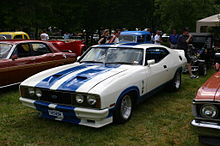 Ford Falcon Cobra 351 V8
Ford Falcon Cobra 351 V8
General Motors Holden produced the Holden Monaro with 161 cu in (2.6 L), 186 cu in (3.0 L) (186 and 186S specification) 6-cylinder engines, 307 cu in (5.0 L), 327 cu in (5.4 L), and 350 cu in (5.7 L) Chevrolet smallblocks and later 253 cu in (4.1 L) and 308 cu in (5.0 L) Holden V8. Followed by the release of four high-performance Toranas, the LC GTR-XU1 (1970–1971) LJ GTR-XU1 (1972–1973), L34 (1974) and the A9X (1977).
The LC XU1 Torana was fitted with a 186 cu in (3.0 L) triple carbureted 6-cylinder engine, later increased with the release of the LJ model to 202 cu in (3.3 L), as opposed to the 308 cu in (5.0 L) single q-barrel carbureted V8 in the SL/R 5000 L34, and SLR5000/SS A9X. There were many homologation changes over the 4 or so years of XU-1 production culminating in a special "Bathurst 1973" specification LJ XU-1 which is probably the most highly prized of the XU-1's.
The L34 was primarily an engine option on the lesser specification LH SL/R 5000 sedan, a factory HO pack providing an upgraded camshaft, Holley carb and other race rady items was also available to those in the know. The basic L34 also gained other homologation features such as much improved brakes and wheel arch flares. The A9X was an option on the LX SLR5000 sedan and the LX SS hatchback (2 door) and unlike the L34 package was not an engine performance upgrade but a suspension, differential and brake upgrade as the L34 engine was already homologated for Group C use. Hence the A9X had a basically standard 308ci engine.
Chrysler produced the R/T Valiant Charger from 1971 to 1973 when the R/Ts were discontinued; the dominant R/T models were the E38 and E49 with high performance 265 cu in (4.3 L) Hemi engines featuring triple Weber carburetors.
Chrysler apparently considered a high-performance V8 program importing 338 340 cu in (5.6 L) V8 engines from the U.S.
That high-performance project never went ahead, and the engines were subsequently fitted to the upmarket 770 model Charger. Initially this model was designated "SE" E55 340 (V8) and only available with automatic transmission; with a model change to the VJ in 1973 the engine became an option, and the performance was lessened.
All Chrysler performance Chargers were discontinued in 1974 with the end of high-performance the 265 Hemi and 340 V8 engines.
The Australian muscle car era is considered to have ended with the release of the Australian Design Rule regarding emissions in ADR27a in 1976. An exception to this rule was the small number of factory-built Bathurst 1000 homologation specials that were constructed after 1976: they are considered to be musclecars. Examples of these homologation specials include the Torana A9X and the Bathurst Cobras.
Later homologation cars were built outside of the factory, many by the Holden Dealer Team (HDT) for track and road use. Although not regarded as true muscle cars, they quickly gained an enthusiastic following. The HDT program was under Peter Brock's direction and had approval from Holden.
Several highly modified high-performance road-going Commodores were produced through the early and mid 1980s. These "homologation specials" were produced to meet the Group A racing regulations. Models included the VC Group C, the VH SS Group III with a 0–100 km/h of 6.7 seconds,[41] the Blue VK SS Group A and the burgundy VL SS Group A. These vehicles are all individually numbered with only 4246 Brock HDT's made and are considered to be collectors' items.
The HDT Commodores are highly collectible muscle cars. Holden Dealer Team vehicles' became more collectible than ever in the wake of Brock's 2006 death.
Showroom-condition HDT cars are generating prices as high as $200,000 AU.[42]
South Africa
In South Africa, Chevrolet placed the Z28 302 Chevrolet smallblock into a Vauxhall Viva coupe bodyshell and called it the Firenza CanAm. Basil Green produced the 302 Windsor – powered Capri Perana. In addition Australian HT and HG GTS Monaros (1969–71) were exported in CKD form and were given a new fascia and rebadged as the Chevrolet SS, which were sold until about 1973. Falcon GTs were also exported to South Africa and rebadged as Fairmont GTs. The Australian XW Falcon GT was called the 1970 Fairmont GT, and the XY Falcon GT was called the Fairmont GT. The Falcons were re-badged as Fairmonts because of the bad reputation of the American Falcons at the time. The Fairmonts were almost the same as their Australian cousins apart from a few cosmetic differences.
United Kingdom
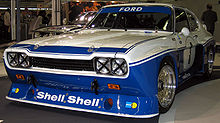 450 bhp (336 kW) Cosworth V6-powered Ford Capri ETC (European Touring Car Championship) race car
450 bhp (336 kW) Cosworth V6-powered Ford Capri ETC (European Touring Car Championship) race car
In the United Kingdom, the muscle car never gained a significant market, but it certainly influenced British manufacturers, with models such as the Ford Capri and Vauxhall Firenza directly inspired by American designs.[citation needed] Ford did, however, fit the Ford Capri with a powerful V6 Engine, introducing the muscle car principle of affordable power to the British public. The Dagenham built 2944 cc Ford Capri 3000GT (or 3000E in more luxurious trim), together with the Ford Capri 2600GT produced at Ford's plant in Cologne, were both muscle cars in spirit. Although the Ford Capri was, in essence, a pony car, GM responded with the Opel Commodore Coupe which was based on the mid-size Opel Rekord. In GTE form and fitted with a six cylinder engine, it was able to match the Fords for performance. Later, both Ford and Vauxhall continued the tradition of producing high performance variants (known colloquially as Q-cars) of its family cars, though these tended to have subtle styling - the effect being to create a discreet performance car.
British Leyland also produced a native 'muscle car in miniature' when it fitted the Rover V8 engine (itself an ex-Buick design) into its MGB GT sports car. With a 3.5-litre V8, manual transmission with overdrive and rear-wheel drive through a leaf sprung live axle the MGB GT V8 had many of the features of a muscle car including good performance (a top speed of 125 MPH) at reasonable cost. Despite being warmly received by the motoring press the V8-engined MGB sold only 2,591 examples in its 3-year production run between 1973 and 1976.
Modern muscle cars
North America
In the late 1980s, there was resurgence in ponycar popularity with the Chevrolet Camaro and the Ford Mustang. But until the early 1990s Fords SVT (Special Vehicle Team) program wanted to up the power and performance. Ford’s 1995 SVT Cobra R was the first to hit the 300 horsepower mark, classic musclecar territory, but was only limited to 250 models. The GM and Ford market rivalry continued throughout the late 90’s where Mustang Cobra and Camaro SS were both rated at 300+ horsepower for standard production models.
For larger cars available in the U.S., the full-size, 4-door Chevrolet Impala SS was available from 1994 to 1996, as a high-performance version of the Caprice equipped with a Corvette-derived 5.7 L V8 LT1 engine and other specific performance features and body styling using the options found on the Caprice 9C1 police package. The Impala SS nameplate was resurrected in 2003 as a high-performance version of the standard Impala with larger and/or supercharged engines. General Motors discontinued its F-body pony-car models, the Chevrolet Camaro and Pontiac Firebird after 2002, but brought back the GTO in 2004 as a rebadged Holden Monaro imported from Australia. Sales were poor and the "new" GTO was discontinued after three years. The Pontiac brand was eliminated after the 2010 model year. Ford's Special Vehicle Team also released the 2003 SVT Cobra, now supercharged, but stopped production after 2004 to make way for the new generation Mustang. For 2012 model year Ford brought back the famous Boss 302. A 444 hp (331 kW) 5.0 V8 was under the hood.
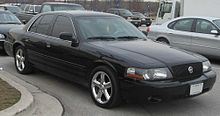 2003-2004 Mercury Marauder
2003-2004 Mercury Marauder
For 2003 and 2004 Mercury revived its Marauder nameplate, as a high-performance version Mercury Grand Marquis based on the Ford Crown Victoria Police Interceptor. In 2005, a "retro-inspired" version of the pony car Ford Mustang drew its design cues from the original 1960s Mustangs. In 2007 Ford and Shelby also re-released a new G.T. 500, with Super Snake and King of the Road editions added in 2008. Saleen introduced a special edition echoing the Boss 302 Mustang naming it the "S302 Parnelli Jones" after the Trans-Am series driver from the 1960s and 1970s, Parnelli Jones (a subsequent similar model followed with Dan Gurney's namesake).
In 2004 Chrysler introduced their LX platform that serves as the platform for a new line of rear-wheel drive, V8-powered cars (using the new Hemi engine), including a four-door version of the Dodge Charger. It was also available as a station wagon (the Dodge Magnum) and the performance of the new models equaled many of the vintage muscle cars. Dodge revived two "classic" model names with the Charger: Daytona in 2006 and the Dodge Charger Super Bee in 2007..
GM's Cadillac division introduced the XLR roadster in 2004 that was produced alongside the Chevrolet Corvette in GM's Bowling Green, Kentucky manufacturing plant. This led to the creation of the Cadillac V-series for the luxury CTS sedan, sold as the CTS-V.
Muscle car revival[43]
Recently a muscle car revival has been seen.
In 2004, Chrysler debuted the true ancestor of the muscle car, 300C, as a 2005 model. Its styling is heavily borrowed from the original 1957 300C model.
In 2005 Ford, as a precursor of this movement, introduced the new Mustang designed to resemble the original 1964.5 model.
In 2008 Chrysler re-introduced the Dodge Challenger. It has strong design links to the 1970 model (i.e. featuring long lines not seen in vehicles and quad headlights).
In 2009 Chevrolet released the new Camaro which bears some resemblance to the 1969 model.
In 2010, Dodge re-introduced the Charger as a 2011 model. The Charger was first reborn in 2006 as a muscle car with its own unique stylings. However, the 2011 version of the Charger took many styling cues from the 1968-70 Charger, thus making the new Charger look more original than the 2006-2010 model.
Australia
Australian Ford and Holden are currently producing high performance vehicles. For instance, Holden has its SS and SSV Commodores and Utilities, and HSV has more powerful Holden based versions and currently producing a limited edition HSV W427 - a Commodore fitted with the 7 litre V8 from the C6 Corvette Z06. Ford Performance Vehicles (FPV) turns out similarly uprated special versions of the Ford Falcon Sedan, the major difference being Ford offer a 360 hp (270 kW) turbocharged 4.0 litre I6 as well as their V8s. FPV are producing the GT 4-door Falcons—both Boss V8 and turbocharged sixes; the premier Fords are currently the BOSS V8 and F6 turbocharged inline 6.
Holden Special Vehicles currently produces high-performance versions of various rear-drive Holden Commodore sedans and, fitted with high performance (400 hp) V8 engines, and are perhaps one of the closest contemporary equivalents to the classic American muscle car (excluding the AWD of course)—-fast, exciting, but relatively crude automobiles (though with far more attention to handling, suspension, safety, and brakes compared with the stock models).
Vauxhall introduced the Monaro to the UK in 2004. This was a re-badged Holden Monaro fitted with a 5.7 litre Chevrolet Corvette engine, or in VXR form with the engine bored out to 6.0 litres. However sales were disappointing and the car was withdrawn from the Vauxhall range in 2007.
Collectibility
The original "tire-burning" cars such as the AMC Machine, Buick Gran Sport, Dodge Charger R/T, Ford Mustang, Oldsmobile 4-4-2, Plymouth GTX and Pontiac GTO, are "collector's items for classic car lovers."[44]
Surviving muscle models are now prized, and certain models carry prices to rival some of the more highly valued European sports cars. At auction the rarest vintage 1965–1972 muscle cars can be appraised at over US$500,000 depending on model, options, condition, demand and availability. Some rare models like the 1969 Chevrolet Camaro with the ZL1 option are considered the equivalent of real estate or museum relics.[citation needed]
Reproduction muscle-car sheet metal parts and even complete body shells are available.
Models
United States
Motor Trend identified the following models as "musclecars" in 1965:
- 1962–1965 Dodge Dart 413/426 Max Wedge/426 Hemi/Plymouth Fury 413/426 Max Wedge/426 Hemi
- 1964–1965 Ford Thunderbolt 427
- 1965–1969 Buick Skylark Gran Sport
- 1965–1970 Dodge Coronet/Plymouth Belvedere 426-S
- 1965 Chevrolet Chevelle Malibu SS
- 1965–1967 Oldsmobile Cutlass 442
Road & Track identified the following models as "musclecars" in 1965:
- 1964–1965 Pontiac Tempest Le Mans/GTO
- 1965–1975 Buick Riviera Gran Sport
- 1965–1969 Buick Skylark Gran Sport
- 1965–1970 Dodge Coronet/Plymouth Belvedere 426-S
- 1965 Chevrolet Chevelle Malibu SS
- 1965–1967 Oldsmobile Cutlass 442
Car and Driver also created a list of the 10 Best muscle cars for its January 1990 issue. The magazine focused on the engines and included:
- 1966–1967 Plymouth/Dodge intermediates with 426 Hemi
- 1968–1969 Plymouth/Dodge intermediates with 426 Hemi
- 1970–1971 Plymouth/Dodge intermediates with 426 Hemi
- 1966–1967 Chevy II SS327
- 1966–1969 Chevrolet Chevelle SS396
- 1968–1969 Chevy II Nova SS396
- 1969 Ford Torino Cobra 428
- 1969 Plymouth Road Runner/Dodge Super Bee 440 Six Pack
- 1970 Chevrolet Chevelle SS454
- 1969 Pontiac GTO
- 1984-1987 Buick Grand National
- 1983-1987 Chevrolet Monte Carlo SS
Other muscle cars include the following:
Full-size muscle models
- 1962-1970 Buick Wildcat
- 1965-1974 Buick Riviera GS until 1972, then Riviera GS Stage1 models
- 1961-1976 Chevrolet Impala SS until '69, then any high HP-engined models
- 1958-1975 Chevrolet Bel Air
- 1958-1972 Chevrolet Biscayne
- 1965-1976 Chevrolet Caprice
- 1959-1975 Ford Galaxie
- 1962-1967 Mercury S-55 (1964 and 1965 badged as a Marauder)
- 1959-1974 Mercury Monterey
- 1960-1973 Dodge Polara
Mid-size muscle models
- 1970–1971 AMC Rebel and Matador The Machine[45][46]
- 1968–1969 Buick Gran Sport
- 1970–1974 Buick GSX
- 1965–1973 Chevrolet Chevelle SS
- 1966–1974 Dodge Charger
- 1968–1971 Dodge Super Bee
- 1969 Dodge Charger Daytona[47]
- 1966–1969 Ford Fairlane GT, GTA, and Cobra
- 1968–1974 Ford Torino (GT, Cobra, and Talladega)
- 1966-1972 Mercury Cyclone
- 1970-1971 Mercury Montego
- 1968–1971 Oldsmobile 442
- 1969 Oldsmobile Cutlass "Ram-Rod" 350
- 1970 Oldsmobile Cutlass W-31
- 1967–1971 Plymouth GTX
- 1968–1974 Plymouth Road Runner[47]
- 1970 Plymouth Superbird
- 1964–1974 Pontiac GTO
Compact muscle models
- 1969 AMC SC/Rambler
- 1971 AMC Hornet SC 360
- 1963–1974 Chevrolet Nova SS
- 1968–1976 Dodge Dart GT, GTS, Swinger, and Demon
- 1970–1976 Plymouth Duster
- 1964-1969 Ford Falcon
- 1970-1976 Ford Maverick Grabber
- 1964-1975 Mercury Comet
Pony car muscle models
- 1968–1970 AMC AMX
- 1968-1974 AMC Javelin and AMX
- 1967-1974 Chevrolet Camaro Z/28 & SS
- 1970–1974 Dodge Challenger
- 1965-1970 Shelby Mustang GT350 & GT500
- 1967-1971 Mustang Cobra Jet
- 1969-1973 Mustang Mach 1
- 1969-1970 Boss 302 Mustang
- 1969-1970 Mustang Boss 429
- 1971 Mustang Boss 351
- 1969-1970 Mercury Cougar Eliminator
- 1964–1974 Plymouth Barracuda
- 1967-1979 Pontiac Firebird & Trans Am
Muscle trucks
- 1965-1987 Chevrolet El Camino SS
- 1967-1979 Ford Ranchero
- 1971-1977 GMC Sprint
- 1978-1987 GMC Caballero
Australia
Chrysler
VH model
- 1971-1972 Charger R/T E37 (101 built)
- 1971-1972 Charger R/T E38 - 280 bhp (210 kW) - 3 Speed Gearbox (Track pack and Big tank were options and a fully blueprinted engine) (316 built)
- 1972-1973 Charger R/T E48 (2 built)
- 1972-1973 Charger R/T E49 - 302 bhp (225 kW) - 4 Speed Gearbox (Track pack and Big tank were options and a fully blueprinted engine) (149 built)
- 1972-1973 Charger S/E E55 - 275 bhp (205 kW) - 727 Torqueflite Auto (340 cubic inch Chrysler LA engine) (124 built)
- 1969-1971 Valiant Hardtop (318 or 360ci V8s)
VJ model (R/T nomenclature dropped) were:
- 1973-1974 Charger E48 (169 built)
- 1973 Charger E49 (4 built)
- 1973-1974 Charger 770 E55 (212 built)
Ford
- 1967 XR Falcon GT (289)
- 1968 XT Falcon GT (302)
- 1969–1970 XW Falcon GT (351)
- 1969–1970 XW Falcon/Fairmont GS 302 and 351
- 1969 XW Falcon GTHO Phase I (351W)
- 1970 XW Falcon GTHO Phase II (351C)
- 1970-1971 XY Falcon/Fairmont GS 302 and 351
- 1970-1971 XY Falcon GT (351)
- 1971 XY Falcon Phase III GTHO (351)
- 1972 XA Falcon Phase IV GTHO 4 door (only four made: three prototypes, one production) (351)
- 1972–1973 XA Falcon GT hardtop coupe/4 Door Sedan (351)
- 1972–1973 XA Falcon GS Hardtop/Sedan/Ute (302, 351)
- 1973 XA Falcon Superbird (302)
- 1973–1976 XB Falcon GT hardtop coupe/4 Door Sedan (351)
- 1973–1976 XB Falcon/Fairmont GS Hardtop/Sedan/Ute (302, 351)
- 1974–1975 XB Falcon John Goss Special (302)
- 1976-1979 XC Fairmont GXL (302C or 351C as the desirable GT Power-pack Option)
- 1978 XC Falcon Cobra 5.8, Bathurst Homologation
- 1979 XD Fairmont Ghia ESP (302C, 351C)
- 1982-84 XE Fairmont Ghia ESP (302C, 351C)
Holden
- 1968–1969 HK Monaro GTS (327)
- 1969–1970 HT Monaro GTS (350)
- 1970–1971 HG Monaro GTS (350)
- 1971–1974 HQ Monaro GTS (350)
- 1974–1976 HJ Monaro GTS (308)
- 1970–1971 LC Torana GTR XU-1 (186)
- 1972–1973 LJ Torana GTR XU-1 (202)
- 1974–1976 LH Torana SL/R 5000 (308)
- 1974 LH Torana SL/R 5000 L34 (308)
- 1976–1978 LX Torana SL/R 5000 (308)
- 1976–1978 LX Torana SS (308)
- 1977 LX Torana SL/R 5000 A9X (308)
- 1977 LX Torana SS A9X (308)
Leyland
- P76 "Force Seven". This was a coupe version of the Leyland P76, and the company's answer to the Holden Monaro GTS, Ford Falcon GT and Chrysler Valiant Charger. The company ran into financial difficulties and ceased Australian production before the 3 door Force Seven could be released. The eight completed examples were sold at auction.
Brazil
- 1971-1975 1st generation Opala SS with engine 250 I6
- 1975-1979 2nd generation Opala SS with engine 250-S I6
- 1979-1980 3rd generation Opala SS with engine 250-S I6
- 1976-1979 1st generation Caravan SS
- 1980 2nd generation Caravan SS
- 1971-1975 1st generation Maverick GT 302 V8
- 1975-1979 2nd generation Maverick GT 302 V8
- 1966-1971 Galaxie 500 289 V8
- 1971-1980 LTD Landau 302 V8
- 1980-1983 Landau 302 V8
- 1969-1975 Dart 318 V8
- 1971-1979 1st generation Charger R/T 318 V8 (1969 Dart modified sold under the name of Charger)
- 1980 2nd generation Charger R/T 318 V8 (1976 Dart modified sold under the name of Charger)
Santa-Matilde
- 1979-1988 SM4.1
See also
References
- ^ Koch, Jeff (1 October 2004). "The First Muscle Car: Older Than You". Hemmings Muscle Machines. http://www.hemmings.com/mus/stories/2004/10/01/hmn_feature17.html. Retrieved 9 January 2011.
- ^ "muscle car". Merriam-Webster Online. http://www.merriam-webster.com/dictionary/muscle%20car. Retrieved 9 January 2011.
- ^ "Muscle Car Definition". Muscle Car Club. http://www.musclecarclub.com/musclecars/general/musclecars-definition.shtml. Retrieved 6 January 2011.
- ^ Sherman, Don (June 4, 2006). "Muscle Cars Now Worth Millions". The New York Times. http://www.nytimes.com/2006/06/04/automobiles/04MILLION.html. Retrieved 6 January 2011.
- ^ "Classic Muscle Cars Library". How Stuff Works. http://musclecars.howstuffworks.com/classic-muscle-cars. Retrieved 6 January 2011.
- ^ "Muscle Car Definition". Muscle Car Society. http://www.musclecarsociety.com/muscle-car-definition. Retrieved 6 January 2011.
- ^ a b c d Henshaw, Peter (2004). Muscle Cars. Thunder Bay Press. ISBN 9781592233038.
- ^ Mueller, Mike (1997). Motor City Muscle: The High-Powered History of the American Muscle Car. MBI Publishing. p. 13. ISBN 9780760301968. http://books.google.com/books?id=ZLP8kKL4w2kC&pg=PA13&dq=muscle+car+definition. Retrieved 6 January 2011.
- ^ a b Auto editors of Consumer Guide (16 January 2007). "The Birth of Muscle Cars". musclecars.howstuffworks.com. http://musclecars.howstuffworks.com/muscle-car-information/how-muscle-cars-work1.htm. Retrieved 6 January 2011.
- ^ a b Musclecars magazine, 1994.[not in citation given]
- ^ Nerad, Jack. "Oldsmobile Rocket 88". Driving Today. http://www.drivingtoday.com/kpix/greatest_cars/olds_rocket88/index.html. Retrieved 6 January 2011.
- ^ Dulcich, Steve (August 2007). "Rocket Man". Popular Hot Rodding. http://www.popularhotrodding.com/features/0708phr_general_motors_432_ci_oldsmobile/index.html. Retrieved 6 January 2011.
- ^ Chrysler 300 article by the editors at Edmunds.com. Retrieved on June 05, 2008.[not in citation given]
- ^ Auto editors of Consumer Guide (22 August 2007). "1957-1960 Rambler Rebel". auto.howstuffworks.com. http://auto.howstuffworks.com/1957-1960-rambler-rebel2.htm. Retrieved 6 January 2011.
- ^ a b Auto editors of Consumer Guide (20 December 2006). "AMC Muscle Cars". auto.howstuffworks.com. http://musclecars.howstuffworks.com/muscle-car-information/amc-muscle-cars.htm. Retrieved 6 January 2011.
- ^ Shaw, Tom (December 2005). "Anatomy of a Lightweight". Legendary Ford.
- ^ a b c d Auto editors of Consumer Guide (30 November 2007). "Ford Thunderbolt". musclecars.howstuffworks.com. http://musclecars.howstuffworks.com/classic-muscle-cars/1964-ford-thunderbolt.htm. Retrieved 8 January 2011.
- ^ a b Holder, Bill; Kunz, Phil (2006). Extreme Muscle Cars: The Factory Lightweight Legacy. Krause Publications. ISBN 9780896892781.
- ^ Gunnell, John (2005). American Cars of the 1960s: A Decade of Diversity. Krause Publications. ISBN 9780896891319.
- ^ "Chevrolet's 1963 Z-11 Impala". 348-409.com. http://www.348-409.com/z11.html. Retrieved 2011-08-07.
- ^ Name (required) (2007-07-02). "The Legendary “409″ Chevy “Continued” « CarsFromYesterday.com". Carsfromyesterday.wordpress.com. http://carsfromyesterday.wordpress.com/2007/07/02/the-legendary-409-chevy-continued/. Retrieved 2011-08-07.
- ^ Auto editors of Consumer Guide (5 January 2007). "1966 Plymouth Satellite 426 Hemi". musclecars.howstuffworks.com. http://musclecars.howstuffworks.com/classic-muscle-cars/1966-plymouth-satellite-426-hemi.htm. Retrieved 8 January 2011.
- ^ a b c Auto editors of Consumer Guide (11 January 2007). "1969 Chevrolet Chevelle COPO 427". musclecars.howstuffworks.com. http://musclecars.howstuffworks.com/classic-muscle-cars/1969-chevrolet-chevelle-copo-427.htm. Retrieved 8 January 2011.
- ^ Auto editors of Consumer Guide (10 January 2007). "1970 Chevrolet Chevelle SS 454". musclecars.howstuffworks.com. http://musclecars.howstuffworks.com/classic-muscle-cars/1970-chevrolet-chevelle-ss-454.htm. Retrieved 8 January 2011.
- ^ a b Car Life January 1969.
- ^ Auto editors of Consumer Guide (9 January 2007). "1968 Plymouth GTX". musclecars.howstuffworks.com. http://musclecars.howstuffworks.com/classic-muscle-cars/1968-plymouth-gtx.htm. Retrieved 9 January 2011.
- ^ a b c Auto editors of Consumer Guide (10 January 2007). "1970 Plymouth Duster 340". musclecars.howstuffworks.com. http://musclecars.howstuffworks.com/classic-muscle-cars/1970-plymouth-duster-340.htm. Retrieved 9 January 2011.
- ^ a b Kelly, Steve (March 1970). "A new entry: DUSTER". Hot Rod.
- ^ Genat, Robert; Newhardt, David; Gale, Tom (2006). Mopar Muscle: Fifty Years: Doge, Plymouth & Chrysler Performance. MBI Publishing. ISBN 9780760326794.
- ^ Cheetham, Craig (2007). Ultimate Muscle Cars. MBI Publishing. pp. 12–15. ISBN 9780760328347.
- ^ Auto editors of Consumer Guide (12 January 2007). 1970 "AMC Rebel Machine". musclecars.howstuffworks.com. http://musclecars.howstuffworks.com/classic-muscle-cars/1970-amc-rebel-machine.htm 1970. Retrieved 8 January 2011.
- ^ Kunz, Bruce (24 December 2007). "1970 AMC Rebel". St. Louis Post-Dispatch. http://more.stltoday.com/stltoday/autos/columnists.nsf/oldcarcolumn/story/e29f5b221d816d6f862573bb005a3428?OpenDocument. Retrieved 9 January 2011.
- ^ Nerad, Jack. "American Motors Rebel Machine". Driving Today. http://www.drivingtoday.com/kpix/greatest_cars/amc_rebel_machine/index.html. Retrieved 8 January 2011.
- ^ Stunkard, Geoff (December 2007). "Welcome To The Machine". Mopar Muscle. http://www.moparmusclemagazine.com/featuredvehicles/amc/mopp_0712_1970_american_motors_rebel_machine/index.html. Retrieved 8 January 2011.
- ^ Sanders, Bill (February 1969). "Road Runner". Motor Trend.
- ^ Auto editors of Consumer Guide (8 January 2007). "1968 Dodge Super Bee". musclecars.howstuffworks.com. http://musclecars.howstuffworks.com/classic-muscle-cars/1968-dodge-super-bee.htm. Retrieved 9 January 2011.
- ^ Kelly, Steve (December 1968). "Barracuda on the Line". Hot Rod.
- ^ Nichols, Mel. "HO down the Hume". falcongt.com.au. http://falcongt.com.au/HO-DTH.html. Retrieved 9 January 2011.
- ^ See a copy of the front page is shown at the start of a Phase 4 documentary with the headline: 160mph 'Super Cars' Soon, (25 June 1972), The Sun-Herald[dead link]
- ^ Wright, John (1987). "The Final Finest Phase". Super Ford's (www.gtho4.com): 20–27. http://www.gtho4.com/The-Final-Finest-Phase-1987.pdf. Retrieved 9 January 2011.
- ^ quickest HDT according to Modern Motor Magazine, January 1983
- ^ According to the Australian 5/2007 Wheels Magazine.
- ^ "2009 Camaro; The Essential Guide To Muscle Cars". Musclecarfacts.net. http://musclecarfacts.net/2009-camaro.html. Retrieved 6 January 2011.
- ^ Zuehlke, Jeffrey (2007). Classic Cars. Lerner Publications. p. 18. ISBN 978-0822559269. http://books.google.com/books?id=XI5-lBJ4bFAC&printsec=frontcover&source=gbs_summary_r&cad=0#PPT19,M1.
- ^ Auto editors of Consumer Guide (12 January 2007). "1970 AMC Rebel Machine". auto.howstuffworks.com. http://musclecars.howstuffworks.com/classic-muscle-cars/1970-amc-rebel-machine.htm. Retrieved 9 January 2011.
- ^ Stakes, Eddie. "Matador Machine: 1971 from American Motors". planethoustonamx. http://www.planethoustonamx.com/stuff/matador_machine.htm. Retrieved 9 January 2011.
- ^ a b Moriarty, Frank (1995). Supercars: The Story of the Dodge Charger Daytona and Plymouth Superbird. Howell Press. ISBN 978-1574270433.
External links
 Media related to Muscle cars at Wikimedia Commons
Media related to Muscle cars at Wikimedia CommonsAmerican Muscle Cars Motor Trend (1965) 1962–1965 Dodge Dart 413/426 Max Wedge/426 Hemi/Plymouth Fury 413/426 Max Wedge/426 Hemi · 1964–1965 Ford Thunderbolt 427 · 1965–1969 Buick Skylark Gran Sport · 1965–1970 Dodge Coronet/Plymouth Belvedere 426-S · 1965 Chevrolet Chevelle Malibu SS · 1965–1967 Oldsmobile Cutlass 442Road & Track (1965) 1964–1965 Pontiac Tempest Le Mans/GTO · 1965–1975 Buick Riviera Gran Sport · 1965–1969 Buick Skylark Gran Sport · 1965–1970 Dodge Coronet/Plymouth Belvedere 426-S · 1965 Chevrolet Chevelle Malibu SS · 1965–1967 Oldsmobile 442 Oldsmobile Cutlass 442Car and Driver (1990) 1966–1967 Plymouth/Dodge intermediates with 426 Hemi · 1968–1969 Plymouth/Dodge intermediates with 426 Hemi · 1970–1971 Plymouth/Dodge intermediates with 426 Hemi · 1966–1967 Chevy II SS327 · 1966–1969 Chevrolet Chevelle SS396 · 1968–1969 Chevy II Nova SS396 · 1969 Ford Torino Cobra 428 · 1969 Plymouth Road Runner/Dodge Super Bee 440 Six Pack · 1970 Chevrolet Chevelle SS454 · 1969 Pontiac GTOMid-Size 1970–1971 AMC Rebel and Matador The Machine · 1970–1974 Buick GSX · 1965–1973 Chevrolet Chevelle SS · 1966–1974 Dodge Charger · 1968–1971 Dodge Super Bee · 1969–1970 Dodge Charger Daytona · 1966–1969 Ford Fairlane GT, GTA, and Cobra · 1968–1974 Ford Torino (GT, Cobra, and Talladega) · 1966-1972 Mercury Cyclone · 1970-1971 Mercury Montego · 1968–1971 Oldsmobile 442 · 1969 Oldsmobile Cutlass "Ram-Rod" 350 · 1970 Oldsmobile Cutlass W-31 · 1967–1971 Plymouth GTX · 1968–1974 Plymouth Road Runner · 1970 Plymouth Superbird · 1964–1974 Pontiac GTOSport compact 1969 AMC SC/Rambler · 1971 AMC Hornet SC 360 · 1963–1974 Chevrolet Nova SS · 1968–1976 Dodge Dart GT, GTS, Swinger, and Demon · 1970–1976 Plymouth DusterPony car 1968–1970 AMC AMX · 1968-1974 AMC Javelin and AMX · 1967-1974 Chevrolet Camaro SS, Z-28 · 1970–1974 Dodge Challenger · 1965-1969 Shelby Mustang GT350 & GT500 · 1968-1971 Mustang Cobra Jet · 1969-1973 Mustang Mach 1 · 1969-1970 Boss 302 Mustang · 1969-1970 Mustang Boss 429 · 1971 Mustang Boss 351 · 1969-1970 Mercury Cougar Eliminator · 1964–1974 Plymouth Barracuda aka 'Cuda · 1967-1979 Pontiac Firebird Trans AmCategories:- Muscle cars
- Car classifications
Wikimedia Foundation. 2010.

